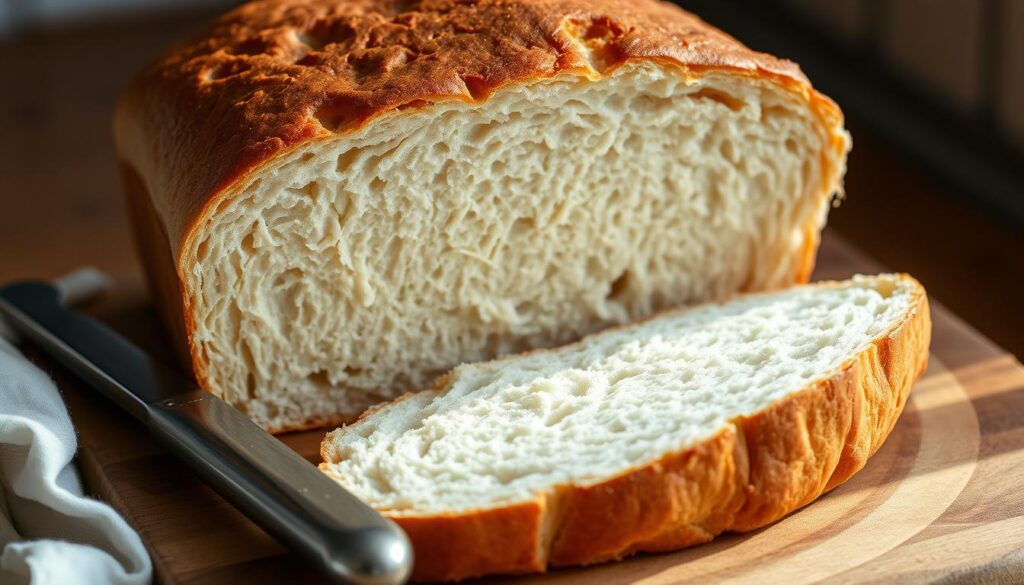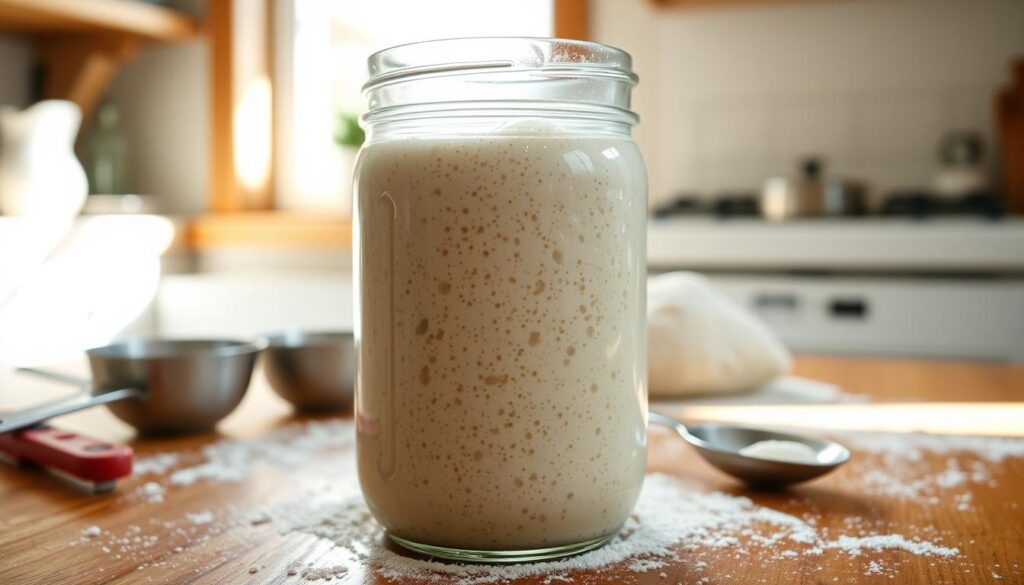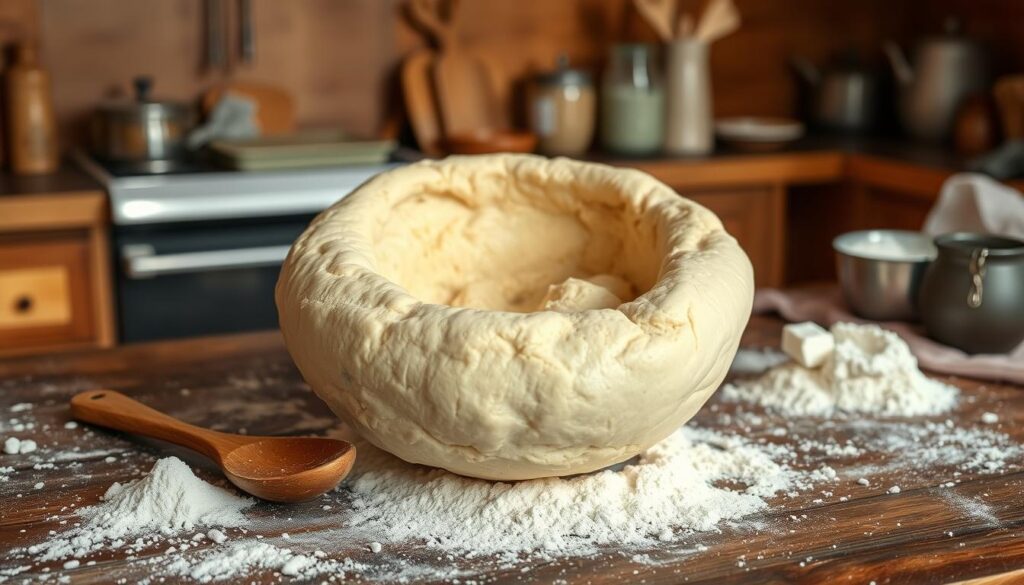There’s nothing quite like the smell of freshly baked bread in your kitchen. This easy sourdough sandwich bread recipe lets you make a delicious loaf for your sandwiches and toast. Sourdough bread uses a sourdough starter to rise, not commercial yeast. This makes the bread taste better, easier to digest, and more nutritious.
Homemade sourdough sandwich bread is a rewarding project. It lets you choose the ingredients and make the loaf just how you like it. Whether you’re new to bread baking or experienced, this recipe will help you every step of the way. Soon, you’ll have a soft, fluffy loaf perfect for sandwiches.
This recipe combines all-purpose flour, olive oil, honey, salt, and a sourdough starter for a tasty loaf. The dough is mixed in a stand mixer, making it easier. After baking, the bread is light and airy with a tangy flavor from the starter. You can also double the recipe and freeze the extra loaf for later, so you always have homemade bread ready.
Table of Contents
Introduction to Sourdough Sandwich Bread
Sourdough sandwich bread is a tasty and healthy choice over store-bought bread. It’s made with a sourdough starter, flour, water, and salt. This artisan bread has a unique taste and a crunchy crust. The fermentation process makes it taste better and easier to digest.

What is Sourdough Sandwich Bread?
Sourdough sandwich bread uses a starter culture for rising. This starter, or levain, has wild yeast and bacteria. It gives sourdough its tangy flavor and light texture.
A typical sourdough sandwich bread recipe might look something like this:
| Ingredient | Amount |
|---|---|
| Sourdough starter | 150g |
| Water | 250g |
| All-purpose flour | 500g |
| Sugar | 15g |
| Salt | 10g |
| Melted butter | 60g |
Benefits of Making Your Own Sourdough Sandwich Bread
There are many benefits to making your own sourdough bread:
- You can choose high-quality, organic, or local ingredients.
- It has fewer additives and preservatives than commercial breads.
- The fermentation process makes it easier to digest.
- It’s rewarding to make a delicious, artisan bread yourself.
The hands-on time for making the bread is around half an hour, while the total time from start to finish is approximately twelve hours.
With patience and practice, you can make a tasty, nutritious sourdough bread at home.
Ingredients Needed for Sourdough Sandwich Bread
To make a tasty sourdough sandwich bread, you need a few key ingredients. The main ingredient is your active sourdough starter. It should be fed 8-12 hours before baking. This recipe uses 75g of peaked sourdough starter for that tangy flavor and chewy texture.

For flour, you can choose between 500g of unbleached all-purpose flour or bread flour. King Arthur Unbleached Bread Flour and Bob’s Red Mill Unbleached All-Purpose flour work great. Bread flour makes the loaf chewier, while all-purpose flour makes it softer.
In addition to your starter and flour, you’ll need:
- 300g room temperature water (between 70-80°F)
- 22g honey for a touch of sweetness
- 8g fine sea salt to enhance the flavor
- 58g (1/4 cup) softened unsalted butter for richness
The Importance of Measuring Ingredients
When baking sourdough bread, precision is crucial. Using a kitchen scale to weigh your ingredients ensures consistent results. This recipe is designed to create a balanced dough for a tender, flavorful loaf.
Baking is a science, and sourdough bread is no exception. Taking the time to measure your ingredients accurately will pay off in the end.
With these essential ingredients, you’re ready to make a delicious sourdough sandwich bread. It costs about $1 to make. Next, we’ll show you how to prepare your sourdough starter for baking.
Preparing Your Sourdough Starter
Before you start making sourdough sandwich bread, make sure your starter is ready. A strong, bubbly starter is key to a great loaf.
Feed your starter 12 hours before mixing the dough. In a 68-70°F (20-22°C) kitchen, use 1 part starter to 4 parts water and flour for a slow rise. This helps your starter develop flavor and power.
If it’s warmer or you need it sooner, use 1:1:1 starter, water, and flour. This ratio works faster.

When feeding, mix 100g flour with 100g water for every 10g starter. This gives your starter the nutrients it needs to grow.
After feeding, your starter should double in 4-8 hours. It should be bubbly and have a tangy smell. It should also pass the “float test” – it should float in water.
With your starter ready, you can mix and knead your dough. You know you’re starting with a strong base for a delicious loaf.
Step-by-Step Guide to Making Sourdough Sandwich Bread
Making sourdough sandwich bread is a rewarding process. It needs patience and attention to detail. With just 8 simple ingredients and some time, you can make a delicious loaf. It’s perfect for sandwiches, toast, or just enjoying on its own.
Mixing the Dough
Start by mixing your active sourdough starter, bread flour, water, and salt in a large bowl. Mix until they form a shaggy dough. Cover the bowl and let it rest for about an hour. This lets the flour hydrate and the gluten develop.
After resting, knead the dough by hand or with a stand mixer for 10-15 minutes. This makes the dough smooth and elastic. It’s important for a good texture in your loaf.

Bulk Fermentation (First Rise)
Once kneaded, put the dough in a lightly oiled bowl. Cover it with a damp towel or plastic wrap. Let it ferment for 8-12 hours, or until it doubles in size. The sourdough starter will add flavor and help it rise.
| Dough Weight | Recommended Bulk Fermentation Time |
|---|---|
| 500g | 8-10 hours |
| 1000g | 10-12 hours |
Shaping the Dough
After fermentation, shape your dough. Gently remove it from the bowl and place it on a lightly floured surface. Press it into a rectangle, then fold the sides towards the middle. Create a tight log and place it seam-side down in a greased loaf pan.
Shaping the dough is like wrapping a present. Be gentle, yet firm, to create a neat and tidy package that will rise beautifully in the oven.
Final Proofing (Second Rise)
Cover the loaf pan with a damp towel or plastic wrap for the final proof. This takes 1-3 hours, depending on your kitchen’s temperature. The dough is ready when it fills the pan and rises about an inch above the rim.
Preheat your oven to 350°F (175°C) during the final proof. With patience and care, you’ll soon have a delicious sourdough sandwich bread to enjoy.
Tips for Achieving the Perfect Sourdough Sandwich Bread
Making the perfect sourdough sandwich bread needs focus and a few important tips. Knowing how your kitchen, ingredients, and dough consistency affect the bread helps you make a tasty, fluffy loaf every time.
Adjusting for Kitchen Temperature and Humidity
Your kitchen’s temperature and humidity can greatly affect your sourdough bread’s fermentation. The best dough temperature is about 78°F (25°C). If it’s warm or humid, you might need to adjust your proofing times or find a cooler spot for your dough. On the other hand, if it’s cold, you might need to extend your proofing times or find a warmer spot.
Using the Right Flour
Choosing the right flour is key for the perfect texture and rise in your sourdough sandwich bread. Unbleached all-purpose or bread flour work well, giving your dough the structure and strength it needs. When feeding your sourdough starter, use a 1:3:3 ratio by weight for the best results.
Achieving the Ideal Dough Consistency
The dough for sourdough sandwich bread should be smooth and slightly tacky, but not too sticky. After mixing, you’ll have a shaggy dough that needs about 30 minutes of autolyze to improve its extensibility. During bulk fermentation, do stretches and folds every 30 minutes to strengthen the dough.
| Loaf Pan Size | Total Dough Weight |
|---|---|
| 8.5 x 4.5 x 2.5 (small) | 600-700g |
| 9 x 5 x 2.75 (medium) | 700-800g |
| 9 x 4 x 4 (Pullman) | 800-900g |
| 13 x 4 x 4 (large Pullman) | 1,100-1,200g |
Adjust the flour or water as needed to get the perfect consistency. The recipe makes two loaves, each about 800g, with a hydration of 48% and a levain of 19.5% in the final dough.
By considering these factors and making the necessary adjustments, you’ll be well on your way to creating the perfect sourdough sandwich bread that’s both delicious and satisfying.
Troubleshooting Common Issues
When baking sourdough sandwich bread, you might face some problems. Knowing how to fix these issues can help you bake successfully.
Your sourdough starter’s health is key. It should double in size in 3-4 hours after feeding. If it doesn’t, check if it’s active and your kitchen is warm, between 75°F to 80°F. Feed it regularly, once or twice a day, to keep the yeast strong.
If your dough is too sticky to shape, it’s likely over-proofed. You can use it to make focaccia instead. Dense or gummy bread can happen if you knead or proof it too little, or if you slice it before it cools fully.
| Issue | Possible Cause | Solution |
|---|---|---|
| Starter not rising | Inactive starter or low temperature | Feed starter regularly and ensure warm environment (75°F-80°F) |
| Over-proofed dough | Dough left to rise for too long | Repurpose dough for focaccia bread |
| Dense or gummy bread | Under-kneading, under-proofing, or slicing too soon | Knead sufficiently, allow proper proofing, and cool completely before slicing |
Flour type and water quality also matter. Whole grain flours like rye or whole wheat help fermentation. Keeping a 1:1 flour to water ratio by weight helps avoid bad smells in your starter.
Remember, successful sourdough baking depends 100% on the health of your starter. If problems persist, try adjusting your feeding schedule or get advice from sourdough experts. With time and effort, you’ll master sourdough sandwich bread.
Variations and Customizations
Baking your own sourdough sandwich bread lets you add your own twist. You can mix in different ingredients or change the loaf’s size and shape. This way, you can make a variety of tasty bread variations that fit your taste and dietary needs.
Adding Seeds, Herbs, or Other Flavorings
Boost your sourdough’s flavor and texture by adding seeds, herbs, or other ingredients. Some great options include:
- Seeds: Sesame, sunflower, pumpkin, or poppy seeds
- Herbs: Rosemary, thyme, or oregano
- Dried fruits: Raisins, cranberries, or chopped apricots
- Nuts: Walnuts, pecans, or almonds
- Spices: Cinnamon, nutmeg, or cardamom
When customizing bread recipes, make sure the added ingredients don’t overpower the dough. Aim to keep them to 10-20% of the flour weight. This helps keep the bread’s texture and structure right.
Adjusting the Loaf Size or Shape
Customize your sourdough by changing its size or shape. Here are some ideas:
| Loaf Size/Shape | Dough Weight | Baking Time |
|---|---|---|
| Standard loaf | 1000-1200g | 40-45 minutes |
| Smaller loaves | 500-600g each | 30-35 minutes |
| Rolls or buns | 80-100g each | 20-25 minutes |
For smaller loaves or rolls, watch the baking time to avoid overcooking. Check the bread’s color and internal temperature. It should be 190-200°F (88-93°C) and have the right crust color.
Sourdough Sandwich Bread Recipe
Making sourdough sandwich bread at home is rewarding. It gives you delicious, wholesome loaves. This recipe makes two loaves using a mature sourdough starter and a mix of bread flour and whole wheat flour. With a few simple steps and patience, you’ll have fresh, flavorful bread.
To start, gather your ingredients and tools, including:
- 150 grams mature sourdough starter
- 500 grams whole milk, warmed to 85ºF
- 600 grams bread flour
- 100 grams whole wheat flour
- 15 grams kosher salt
- 10 grams beeswax (optional)
- 30 grams unsalted butter, softened
- Two 8 1/2″ x 4 1/2″ bread pans
The sourdough sandwich bread making process takes three days. Most time is spent fermenting and proofing the dough. On day one, feed your sourdough starter between 8-9 PM. The next morning, mix the dough ingredients and knead for 7 minutes with a stand mixer.
Let the dough bulk ferment for 3-5 hours. It should increase in size by about 25% and feel airy and smooth.
After bulk fermentation, divide the dough into two equal parts. Shape each into a loaf. Place the loaves in greased pans and cover with plastic wrap. Refrigerate for up to 18 hours to slowly proof and develop flavor.
On baking day, remove the loaves from the fridge and let them warm up for about an hour. Preheat your oven to 400ºF. Before baking, score the top of each loaf with a sharp knife or bread lame. Bake for 15 minutes at 400ºF, then reduce the temperature to 375ºF and bake for another 15 minutes. The total baking time is 50-60 minutes, or until the bread’s internal temperature reaches 190ºF.
| Step | Time | Temperature |
|---|---|---|
| Feed starter | Day 1, 8-9 PM | Room temperature |
| Mix dough | Day 2, morning | Milk at 85ºF |
| Bulk fermentation | 3-5 hours | Room temperature |
| Shape and refrigerate | Up to 18 hours | Refrigerator |
| Bake | 50-60 minutes | 400ºF, then 375ºF |
After baking, remove the loaves from the pans and cool them completely on a wire rack before slicing. Enjoy your homemade sourdough sandwich bread within 3 days. Store it at room temperature in an airtight container or plastic bag.
The aroma of freshly baked sourdough bread filling your kitchen is a simple pleasure that’s hard to beat.
With this sourdough sandwich bread recipe, you can make delicious, artisanal loaves at home. Try different flour mixes and fermentation times to find your favorite flavor and texture.
Storing and Enjoying Your Sourdough Sandwich Bread
After baking your sourdough sandwich bread, it’s key to store it right. This keeps it fresh and tasty. With the right methods, you can enjoy your bread for days.
Slicing and Serving Suggestions
Let your bread cool completely on a wire rack for at least an hour before slicing. This step helps the bread’s texture set right. Use a serrated knife to slice it to your liking.
A good loaf gives you 12 thick slices or 15-16 thinner ones. These are great for sandwiches, toast, or just enjoying by itself.
Storing Leftover Bread
To keep your bread fresh, store it in an airtight container or bread bag at room temperature for up to 3 days. Don’t refrigerate it, as it can stale faster. If your bread starts to dry out, refresh it by heating it in a 350°F oven for 5-10 minutes or toasting individual slices.
| Storage Method | Shelf Life |
|---|---|
| Room Temperature (Airtight Container/Bread Bag) | Up to 3 days |
| Refrigerator | Not Recommended (Can Cause Staling) |
| Freezer (Sliced) | Up to 2-3 months |
Freezing for Later Use
Freezing is a great way to enjoy your sourdough bread longer than 3 days. Slice it before freezing for easy use. Use a freezer-safe bag or container, separating slices with parchment paper to prevent sticking.
Frozen sourdough bread slices can last up to 2-3 months. When you’re ready, just toast a slice from the freezer. No need to thaw first! This makes it easy to have fresh bread ready for quick meals or snacks.
Conclusion
Homemade sourdough bread is a fun and tasty project for home bakers. You only need flour, water, salt, and your sourdough starter. This mix creates a soft, tasty loaf great for sandwiches, toast, or just eating by itself.
The process takes patience and timing, but it’s worth it. By following this recipe, you’ll learn to mix, rise, shape, and bake the dough. It also offers tips for adjusting sourness, using different flours, and solving common problems.
With only 20 minutes of prep and about 3 hours total, you can make this bread easily. Once you get the hang of it, try adding seeds, herbs, or other flavors. Adjust the size and shape to your liking. With practice and creativity, you’ll enjoy homemade sourdough bread often.
How Was Your Experience? Share Your Review!
There are no reviews yet. Be the first one to write one.

